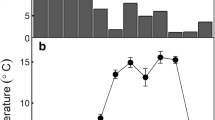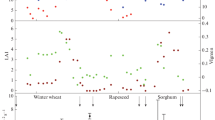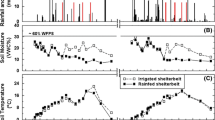Abstract
Within the context of climate change, it is necessary to improve our mechanistic understanding of processes that release CO2 to the atmosphere. This study was designed to investigate spatial variation of soil CO2 efflux (FCO2) at the landscape (catchment) scale, which has received less attention so far in comparison to more homogeneous, smaller areas. More specifically, this study investigated the impacts of water regime, land-use and crop rotation on FCO2 in a small temperate agricultural catchment. FCO2 was measured manually with closed dynamic chambers over a 1 year period (36 weekly to bi-weekly measurement dates) at 22 sites that were selected to represent most of the diversity of drainage classes, soil types and land-uses in a small catchment in North-Western France. FCO2 was modelled empirically at each site as a function of soil temperature and soil water content. As a secondary step, impacts of water regime, land-use and crop rotation on heterotrophic respiration (HR) were also sought, with HR being estimated empirically as a fraction of FCO2 on the basis of partitioning coefficients taken from the literature. Results showed that water regime, land-use and crop rotation all had significant impacts on FCO2 on an annual scale. Poorly-drained sites emitted less CO2 than well-drained and moderately-well drained sites, which could be explained by reduced soil CO2 production and/or limitations in soil transport in more saturated environments. In addition, larger annual FCO2 were measured on grasslands compared to croplands (wheat and maize crops), which is likely due to the presence of larger amounts of available soil carbon and nutrients and to the presence or denser rooting systems. Due to the literature-based determination of partitioning coefficients, the results related to HR estimates were affected by more uncertainties than those related to FCO2 but they showed that the water regime tended to impact them similarly as FCO2, while HR was likely less affected by land-use. Altogether, the results of this study, performed at scale of a small agricultural temperate catchment, confirm that specific patterns of FCO2 result from varying soil CO2 production and transport processes, resulting from complex interactions between soil environment characteristics (soil carbon content, water regime,…) and land-use/crop rotations.







Similar content being viewed by others
References
Akkal-Corfini N, Viaud V, Menasseri-Aubry S, Le Naour E, Rieux C (2014) Typologie des systèmes de culture pratiqués à l’échelle d’un paysage, basée sur la gestion des pratiques à l’échelle d’un territoire impactant potentiellement la dynamique de la matière organiques des sols. Internal MOSAIC project report (WP 1, Task 3), INRA, UMR SAS, Rennes, p 97
Atkins JW, Epstein HE, Welsch DL (2015) Vegetation and elevation influence the timing and magnitude of soil CO2 efflux in a humid, topographically complex watershed. Biogeosciences 12:2975–2994
Bailey NJ, Motavalli PP, Udawatta RP, Nelson KA (2009) Soil CO2 emissions in agricultural watersheds with agroforestry and grass contour buffer strips. Agrofor Syst 77:143–158
Balser TC, McMahon KD, Bart D, Bronson D, Coyle DR, Craig N, Flores-Mangual ML, Forshay K, Jones SE, Kent AE, Shade AL (2006) Bridging the gap between micro- and macro-scale perspectives on the role of microbial communities in global change ecology. Plant Soil 289:59–70
Bond-Lamberty B, Thomson A (2010) Temperature-associated increases in the global soil respiration record. Nature 464:579–582
Bossio DA, Scow KM (1998) Impacts of carbon and flooding on soil microbial communities: phospholipid fatty acid profiles and substrate utilization patterns. Microb Ecol 35:265–278
Byrne KA, Kiely R (2006) Partitioning of respiration in an intensively managed grassland. Plant Soil 282:281–289
Chirinda N, Elsgaard L, Thomsen IK, Heckrath G, Olesen JE (2014) Carbon dynamics in topsoil and subsoil along a cultivated toposequence. Catena 120:20–28
Creed IF, Webster KL, Braun GL, Bourbonnière RA, Beall FD (2013) Topographically regulated traps of dissolved organic carbon create hotspots of soil carbon dioxide efflux in forests. Biogeochemistry 112:149–164
Davidson EA, Janssens IA (2006) Temperature sensitivity of soil carbon decomposition and feedbacks to climate change. Nature 440:165–173
Davidson EA, Janssens IA, Luo Y (2006a) On the variability of respiration in terrestrial ecosystems: moving beyond Q10. Glob Chang Biol 12:154–164
Davidson EA, Savage KE, Trumbore SE, Borken W (2006b) Vertical partitioning of CO2 production within a temperate forest soil. Glob Chang Biol 12:944–956
Dequiet S, Saby NPA, Lelièvre M, Jolivet C, Thioulouse J, Toutain B, Arrouays D, Bispo A, Lemanceau P, Ranjard L (2011) Biogeographical patterns of soil molecular microbial biomass as influenced by soil characteristics and management. Glob Ecol Biogeogr 20:641–652
Drenovsky RE, Vo D, Graham KJ, Scow KM (2004) Soil water content and organic carbon availability are major determinants of soil microbial community composition. Microb Ecol 48:424–430
Drinkwater LE, Wagoner P, Sarrantonio M (1998) Legume-based crop** systems have reduced carbon and nitrogen losses. Nature 396:262–265
DuPont ST, Culman SW, Ferris H, Buckley DH, Glover JD (2010) No-tillage conversion of harvested perennial grassland to annual cropland reduces root biomass, decreases active carbon stocks, and impacts soil biota. Agric Ecosyst Environ 137:25–32
Epron D, Bosc A, Bonal D, Freycon V (2006) Spatial variation of soil respiration across a topographic gradient in a tropical rain forest in French Guiana. J Trop Ecol 22:565–574
Fang C, Moncrieff JB (1999) A model for soil CO2 production and transport 1: model development. Agric For Meteorol 95:225–236
Flechard CR, Neftel A, Jocher M, Ammann C, Leifeld J, Fuhrer J (2007) Temporal changes in soil pore space CO2 concentration and storage under permanent grassland. Agric For Meteorol 142:66–84
Fox J, Weisberg S (2011) An {R} companion to applied regression, 2nd edn. Sage, Thousand Oaks
Goffin S, Wylock C, Haut B, Maier M, Longdoz B, Aubinet M (2015) Modeling soil CO2 production and transport to investigate the intra-day variability of surface efflux and soil CO2 concentration measurements in a Scots Pine Forest (Pinus Sylvestris, L). Plant Soil 390:195–211
Gregorich EG, Drury CF, Baldock JA (2001) Changes in soil carbon under long-term maize in monoculture and legume-based rotation. Can J Soil Sci 81:21–31
Han G, Zhou G, Xu Z, Yang Y, Liu J, Shi K (2007) Biotic and abiotic factors controlling the spatial and temporal variation of soil respiration in an agricultural ecosystem. Soil Biol Biochem 39:418–425
Hanson PJ, Edwards NT, Garten CT, Andrews JA (2000) Separating root and soil microbial contributions to soil respiration: a review of methods and observations. Biogeochemistry 48:115–146
Heinemeyer A, Tortorella D, Petrovičová B, Gelsomino A (2012) Partitioning of soil CO2 flux components in a temperate grassland ecosystem. Eur J Soil Sci 63:249–260
IUSS Working Group WRB (2006) World Reference Base for Soil Resources, 2nd edition. World Soil Resources Reports: 103, FAO, Rome
Jackson RB, Canadell J, Ehleringer JR, Mooney HA, Sala OE, Schulze ED (1996) A global analysis of root distributions for terrestrial biomes. Oecologia 108:389–411
Jones DL, Willett VB (2006) Experimental evaluation of methods to quantify dissolved organic nitrogen (DON) and dissolved organic carbon (DOC) in soil. Soil Biol Biochem 38:991–999
Kätterer T, Reichstein M, Andrén O, Lomander A (1998) Temperature dependence of organic matter decomposition: a critical review using literature data analyzed with different models. Biol Fertil Soils 27:258–262
Kirschbaum MUF (1995) The temperature dependence of soil organic matter decomposition, and the effect of global warming on soil organic C storage. Soil Biol Biochem 27:753–760
Kuzyakov Y (2006) Sources of CO2 efflux from soil and review of partitioning methods. Soil Biol Biochem 38:425–448
Langmuir D (1997) Aqueous environmental geochemistry. Prentice Hall, New Jersey
Lê S, Josse J, Husson F (2008) FactoMineR: an R Package for multivariate analysis. J Stat Softw 25:1–18
Lloyd J, Taylor JA (1994) On the temperature dependence of soil respiration. Funct Ecol 8:315–323
Lohila A, Aurela M, Regina K, Laurila T (2003) Soil and total ecosystem respiration in agricultural fields: effect of soil and crop type. Plant Soil 251:303–317
Longdoz B, Yernaux M, Aubinet M (2000) Soil CO2 efflux measurements in a mixed forest: impact of chamber disturbances, spatial variability and seasonal evolution. Glob Chang Biol 6:907–917
Loubet B, Laville P, Lehuger S, Larmanou E, Fléchard C, Mascher N, Genermont S, Roche R, Ferrara RM, Stella P, Personne E, Durand B, Decuq C, Flura D, Masson S, Fanucci O, Rampon J-N, Siemens J, Kindler R, Gabrielle B, Schrumpf M, Cellier P (2011) Carbon, nitrogen and greenhouse gases budgets over a four years crop rotation in Northern France. Plant Soil 343:109–137
Luo Y, Zhou X (2010) Soil respiration and the environment. Academic Press, London, p 328
Minasny B, McBratney AB (2006) A conditioned Latin hypercube method for sampling in the presence of ancillary information. Comput Geosci 32:1378–1388
Molenat J, Gascuel-Odoux C, Ruiz L, Gruau G (2008) Role of water table dynamics on stream nitrate export and concentration in agricultural headwater catchment (France). J Hydrol 348:363–378
Moyano FE, Manzoni S, Chenu C (2013) Responses of soil heterotrophic respiration to moisture availability: an exploration of processes and models. Soil Biol Biochem 59:72–85
Pacific VJ, McGlynn BL, Riveros-Iregui DA, Welsch DL, Epstein HE (2008) Variability in soil respiration across riparian-hill-slope transitions. Biogeochemistry 91:51–70
Pacific VJ, McGlynn BL, Riveros-Iregui DA, Welsch DL, Epstein HE (2011) Landscape structure, groundwater dynamics, and soil water content influence soil respiration across riparian-hill-slope transitions in the Tenderfoot Creek Experimental Forest, Montana. Hydrol Process 25:811–827
Payraudeau S, van der Werf HMG, Vertès F (2007) Analysis of the uncertainty associated with the estimation of nitrogen losses from farming systems. Agric Syst 94:416–430
Petrone RM, Chahil P, Macrae ML, English MC (2008) Spatial variability of CO2 exchange for riparian and open grasslands within a first-order agricultural basin in Southern Ontario. Agric Ecosyst Environ 125:137–147
Prolingheuer N, Scharnagl B, Graf A, Vereecken H, Herbst M (2014) On the spatial variation of soil rhizospheric and heterotrophic respiration in a winter wheat stand. Agric For Meteorol 195–196:24–31
Pumpanen J, Ilvesniemi H, Kulmala L, Siivola E, Laakso H, Kolari P, Helenelund C, Laakso M, Uusimaa M, Hari P (2008) Respiration in boreal forest soil as determined from carbon dioxide concentration profile. Soil Sci Soc Am J 72:1187–1196
Ranjard L, Lejon DPH, Mougel C, Schehrer L, Merdinoglu D, Chaussod R (2003) Sampling strategy in molecular microbial ecology: influence of soil sample size on DNA fingerprinting analysis of fungal and bacterial communities. Environ Microbiol 5:1111–1120
Raymond JE, Fernandez IJ, Ohno T, Simon K (2012) Soil drainage class influences on soil carbon in a New England forested watershed. Soil Sci Soc Am J 77:307–317
Ricker MC, Stolt MH, Zavada MS (2014) Comparison of soil organic carbon dynamics in forested riparian wetlands and adjacent uplands. Soil Sci Soc Am J 78:1817–1827
Riveros-Iregui DA, McGlynn BL, Marshall LA, Welsch DL, Emanuel RE, Epstein HE (2011) A watershed-scale assessment of a process soil CO2 production and efflux model. Water Resour Res 47(10):W00J04. doi:10.1029/2010WR009941
Riveros-Iregui DA, McGlynn BL (2009) Landscape structure control on soil CO2 efflux variability in complex terrain: scaling from point observations to watershed scale fluxes. J Geophys Res 114:G02010. doi:10.1029/2008JG000885
Rivière JM, Tico S, Dupont C (1992) Méthode tarière—Massif Armoricain—Caractérisation des sols. Laboratoire de Science du Sol INRA Rennes (Eds), Chambre d’Agriculture du Morbihan, Chambre d’Agriculture d’Ille-et-Vilaine, Rennes, pp 20
Rochette P, Flanagan LB, Gregorich EG (1999) Separating soil respiration into plant and soil components using analyses of the natural abundance of carbon-13. Soil Sci Soc Am J 63:1207–1213
Ryan MG, Law BE (2005) Interpreting, measuring, and modeling soil respiration. Biogeochemistry 73:3–27
Schlesinger WH, Andrews JA (2000) Soil respiration and the global carbon cycle. Biogeochemistry 48:7–20
Stielstra CM, Lohse KA, Chorover J, McIntosh JC, Barron-Gafford GA, Perdrial JN, Litvak M, Barnard HR, Brooks PD (2015) Climatic and landscape influences on soil moisture are primary determinants of soil carbon fluxes in seasonally snow-covered forest ecosystems. Biogeochemistry 123:447–465
Suleau M, Moureaux C, Dufranne D, Buysse P, Bodson B, Destain J-P, Heinesch B, Debacq A, Aubinet M (2011) Respiration of three Belgian crops: partitioning of total ecosystem respiration in its heterotrophic, above- and below-ground autotrophic components. Agric For Meteorol 151:633–643
Tang J, Misson L, Gershenson A, Cheng W, Goldstein AH (2005) Continuous measurements of soil respiration with and without roots in a ponderosa pine plantation in the Sierra Nevada Mountains. Agric For Meteorol 132:212–227
Tete E, Viaud V, Walter C (2015) Organic carbon and nitrogen mineralization in a poorly-drained mineral soil under transient waterlogged conditions: an incubation experiment. Eur J Soil Sci 66:427–437
Tufekcioglu A, Raich JW, Isenhart TM, Schultz RC (2001) Soil respiration within riparian buffers and adjacent crop fields. Plant Soil 229:117–124
Verma SB, Dobermann A, Cassman KG, Walters DT, Knops JM, Arkebauer TJ, Suyker AE, Burba GG, Amos B, Yang H, Ginting D, Hubbard KG, Gitelson AA, Walter-Shea EA (2005) Annual carbon dioxide exchange in irrigated and rainfed maize-based agroecosystems. Agric For Meteorol 131:77–96
Viaud V, Angers DA, Walter C (2010) Toward landscape-scale modeling of soil organic matter dynamics in agroecosystems. Soil Sci Soc Am J 74:1847–1860
Walter C, Curmi P (1998) Les sols du bassin versant du Coët-dan Organisation, variabilité spatiale et cartographie. INRA Eds, Paris, pp 85–105
Webster KL, Creed IF, Bourbonnière RA, Beall FD (2008) Controls on the heterogeneity of soil respiration in a tolerant hardwood forest. J Geophys Res 113:G03018. doi:10.1029/2008JG000706
Werth M, Kuzyakov Y (2009) Three-source partitioning of CO2 efflux from maize field soil by 13C natural abundance. J Plant Nutr Soil Sci 172:487–499
Williams MA, Rice CW (2007) Seven years of enhanced water availability influences the physiological, structural, and functional attributes of a soil microbial community. Appl Soil Ecol 35:535–545
Acknowledgments
This research was funded by the National Research Agency (France) within the MOSAIC project (ANR-12-AGRO-0005). The investigations benefited from the support of INRA and CNRS for the Research Observatory ORE AgrHys, and from Allenvi for the SOERE RBV. Data are available at http://geowww.agrocampus-ouest.fr/web/. The authors also thank Armelle Racapé (INRA Rennes—Agrocampus-Ouest—UMR 1069) and Patrice Petitjean (University of Rennes I, Géosciences-Rennes UMR6118) for DOC sample preparation and analysis.
Author information
Authors and Affiliations
Corresponding author
Additional information
Responsible Editor: Susan E. Crow.
Electronic supplementary material
Below is the link to the electronic supplementary material.
Rights and permissions
About this article
Cite this article
Buysse, P., Flechard, C.R., Hamon, Y. et al. Impacts of water regime and land-use on soil CO2 efflux in a small temperate agricultural catchment. Biogeochemistry 130, 267–288 (2016). https://doi.org/10.1007/s10533-016-0256-y
Received:
Accepted:
Published:
Issue Date:
DOI: https://doi.org/10.1007/s10533-016-0256-y




